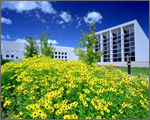
This national laboratory visitor center, designed with sustainable principles, uses passive solar energy for heating and cooling. (Warren Gretz, NREL/PIX05326) |
As the largest single "landlord" in the United States, the federal government oversees about 500,000 federal buildings. More than $20 billion is spent annually on acquiring or substantially renovating federal facilities, more than $3.5 billion for energy for these facilities, and almost $200 billion for personnel compensation and benefits for civilian employees. This represents an enormous opportunity to transfer the sustainable technologies and practices on a large scale and help transform the marketplace. In addition, EO 13123 requires the federal agencies to apply sustainable design principles. With so much to gain in terms of energy, environmental, and economic benefits, it is not surprising that many federal agencies have developed policies to promote sustainable design and operation. In particular, federal policy calls on agencies to:
- Maximize the potential of the site;
- Minimize the energy and resource consumption;
- Protect and conserve water;
- Use environmentally preferable products and materials;
- Enhance indoor environmental quality; and
- Optimize operational and maintenance practices.
By assisting federal agencies to use energy, water, and other resources wisely, FEMP is helping federal agencies contribute to our national goals for energy efficiency, energy security, and sustainability. The Interagency Sustainability Working Group, chaired by FEMP, has a goal of making sustainable design and construction of federal facilities "business as usual".
FEMP encourages agencies to adopt guidelines set forth in the Whole Building Design Guide. In particular, agencies should continually challenge themselves to:
- Establish sustainable design goals early in the planning stages and aim for a minimum equivalent of a LEED silver rating, with additional emphasis on energy efficiency, water conservation and indoor air quality;
- Bring together a multi-disciplinary design team with all building stakeholders, and include them in a design charrette at the outset of the project;
- Strive for a "whole building" design that integrates the architectural and engineered features of the building in relation to its environment;
- Evaluate lifecycle costs in all design and financial decision making;
- Consider making new types of trade-offs, including foregoing certain traditional building electives in order to pay for some more expensive sustainable features; and
- Maintain a commitment to integrate sustainable design principles and practices throughout the design, construction, and operation of the facility.
To learn more about what sustainable design is, why it's important, and what the benefits are, view the basics page.
|

